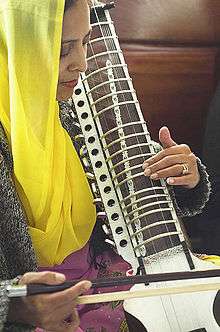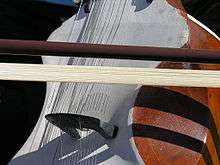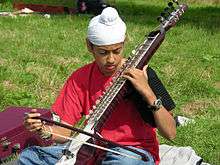Esraj
| Classification | |
|---|---|
| Related instruments | |
The esraj (Bengali: এস্রাজ; Hindi: इसराज; English /ˈɛsrʌdʒ/; also called the Dilruba) is a string instrument found in two forms throughout the north, central, and east regions of the Indian subcontinent. It is a young instrument by Indian terms, being only about 300 years old. The dilruba (दिलरुबा) (From Persian: دلربا) is found in the north, where it is used in religious music and light classical songs in the urban areas. Its name is translated as "robber of the heart." The esraj is found in the east and central areas, particularly Bengal (Indian states of West Bengal and Tripura; and Bangladesh) and it is used in a somewhat wider variety of musical styles than is the dilruba.

The Dilruba originates from the Taus and is the work of the 10th Sikh Guru, Guru Gobind Singh,[1] whilst that of the Taus was the work of Guru Hargobind (the sixth guru of the Sikhs). The Dilruba was then produced to replace the previously heavy instrument (the Taus). This attempt was intended to 'scale down' the Taus into what is now known to be the Dilruba. This made it more convenient for the Sikh army to carry the instrument on horseback.

The structure of both instruments is very similar, each having a medium sized sitar-like neck with 20 heavy metal frets. This neck holds on a long wooden rack of 12-15 sympathetic strings. While the dilruba has more sympathetic strings and a differently shaped body than the esraj, they both have four main strings which are bowed. All strings are metal. The soundboard is a stretched piece of goatskin similar to what is found on a sarangi. Sometimes the instrument has a gourd affixed to the top for balance or for tone enhancement.
The instrument can be rested between the knees while the player kneels, or more commonly rested on the knee of the player while sitting, or also on the floor just in front of the player, with the neck leaning on the left shoulder. It is played with a bow (known as a "gaz"), with the other hand moving along the strings above the frets. The player may slide the note up or down to achieve the portamento, or meend, characteristic of Indian music.

The esraj is mostly used as an accompanying instrument. It is the accompanying instrument of choice for Rabindra Sangeet singing. However, it has also been used as a solo instrument to interpret Hindustani Classical Music, mostly in the Vishnupur tradition. Additionally, the esraj is a more modern invention from the Dilruba that was made and promoted by the Namdharis.
Both the dilruba and the esraj had been declining in popularity for many decades. By the 1980s the instrument was nearly extinct. However with the rising influence of the "Gurmat Sangeet" movement, these instruments are once again attracting considerable attention.
Notable players
A. R. Rahman is known as one of the composers in India who has used the Dilruba, in works like "Dil Se" and "Vande Mataram". Possibly the most famous exponent of the esraj has been Pandit Ranadhir Roy, who died in 1988. Ranadhir Roy was a student of Ashesh Bandopadhyay, and was on the faculty at the Music department of Visva-Bharati University in Santiniketan. Today, the best known exponent is Buddhadeb Das, also from Santiniketan. The esraj was the favourite instrument of the spiritual Master Sri Chinmoy who used it as a meditation tool and outlet for emotion, not necessarily to create or reproduce traditional music from the region.
In South India, the most famous exponent in the film industry to play Dilruba was Dilruba Shanmugham. A great dilruba player, he has been conferred with the Kalaimamani award by the Tamil Nadu Government. He has played innumerous scores on Dilruba for legends like MSV and Ilayaraja.
Ravi Shankar (known then as Rabindra) played the Dilruba in the 1930s, as a member of the dance group of his older brother Uday Shankar.
Indian physicist and mathematician S. N. Bose is also known to have played it.
Famous Bollywood music director Roshan was also a noted Esraj player.
See also
References
- ↑ Dutta, Madhumita (2008). Let's Know Music and Musical Instruments of India. Star Publications. pp. 22–23. ISBN 978-1-9058-6329-7.
